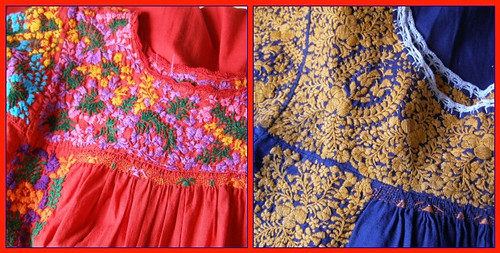The huipil, a traditional garment worn by Indigenous women in Mexico, is much more than a piece of clothing. It is a cultural artifact, an artistic expression, and a symbol of identity that has been passed down through generations. With its vibrant colors, intricate embroidery, and unique patterns, the huipil represents the rich history and traditions of Mexico’s diverse Indigenous communities. In recent years, the huipil has seen a resurgence, as fashion designers, artisans, and cultural advocates strive to preserve and revitalize this beautiful heritage piece in the face of modernization and globalization. This article explores the cultural significance of the huipil, the craftsmanship behind its creation, and its revival in contemporary fashion and cultural consciousness.
1. The History and Cultural Significance of the Huipil
The word “huipil” originates from the Nahuatl language and translates to “blouse” or “dress.” It is one of the oldest garments in Mesoamerica, with origins dating back to pre-Hispanic times, long before the Spanish colonization of Mexico. Worn by women in Indigenous communities across Mexico and Central America, the huipil is typically crafted from cotton or wool and adorned with elaborate embroidery that holds significant cultural and spiritual meanings.
A Symbol of Identity
Each huipil is distinct, representing the culture, beliefs, and regional identity of the woman who wears it. The designs and motifs vary depending on the community, with symbols often reflecting elements of nature, mythology, and spirituality. For example, in some regions, flowers and animals symbolize fertility, while geometric patterns may represent the cosmos or local landscapes. The huipil is not merely a garment; it is a visual narrative, telling the story of the wearer and her community’s connection to the natural and spiritual worlds.
Ritual and Ceremony
Huipils have also played an important role in rituals and ceremonies. They are worn during important life events such as weddings, baptisms, and religious festivals. The ceremonial huipils are often more elaborate, incorporating vibrant colors, sacred symbols, and special materials. These garments become family heirlooms, passed down through generations as a cherished link to ancestry and heritage.
2. Craftsmanship: The Art of Weaving and Embroidery
The creation of a huipil is a labor-intensive process that requires skill, patience, and deep cultural knowledge. Traditionally, huipils are woven on a backstrap loom—a simple yet highly effective tool that has been used for centuries by Indigenous weavers. This loom is tied to a fixed object, such as a tree or post, with the weaver using her body to create the tension needed to weave the fabric.
Weaving Techniques
Backstrap weaving is an ancient technique that allows for incredible control over the weaving process, resulting in textiles that are both strong and intricate. The weaver sits on the ground with the loom attached around her waist, carefully weaving threads into patterns that have been handed down through generations. The process can take weeks or even months, depending on the complexity of the design and the size of the huipil.
Embroidery and Symbolism
Once the fabric is woven, the huipil is embellished with embroidery, which is often done by hand. The embroidery is where much of the huipil’s symbolism comes to life. Common motifs include birds, flowers, stars, and other elements of nature, each carrying specific meanings that reflect cultural beliefs. The colors used in huipil embroidery are also significant, with red often symbolizing life and fertility, blue representing water and the sky, and green denoting nature and growth.
Natural Dyes
Traditionally, the yarn used in huipil weaving is dyed with natural pigments derived from plants, insects, and minerals. Cochineal, a small insect found on prickly pear cacti, is used to create rich red hues, while indigo provides deep blues. The use of natural dyes not only contributes to the beauty of the huipil but also highlights the deep connection between Indigenous communities and their natural environment.
3. Challenges Facing the Huipil Tradition
Despite its cultural richness and artistic value, the tradition of huipil-making faces numerous challenges in the modern era. Globalization, economic pressures, and the allure of mass-produced fashion have all contributed to a decline in the number of women who continue to make and wear huipils. Younger generations, particularly those who migrate to urban areas in search of economic opportunities, may find it difficult to maintain the traditions of their ancestors.
Economic Pressures
The time-consuming nature of huipil-making means that it is often difficult for artisans to compete with cheap, machine-made textiles. Many Indigenous artisans struggle to make a sustainable income from their craft, leading some to abandon traditional weaving altogether. The influx of synthetic fabrics and factory-made clothing has also contributed to the decline of handwoven huipils, as these cheaper alternatives are often more accessible.
Cultural Appropriation
Another challenge facing the huipil tradition is cultural appropriation. In recent years, elements of traditional Mexican textiles, including huipil designs, have been appropriated by international fashion brands without proper acknowledgment or compensation for the artisans who originated these designs. This practice not only undermines the cultural significance of the huipil but also deprives Indigenous artisans of economic opportunities that could help sustain their craft.
4. The Revival of the Huipil: Efforts to Preserve and Promote
In the face of these challenges, there has been a growing movement to preserve and revitalize the art of huipil-making. Cultural organizations, artisans, and designers are working together to ensure that this important aspect of Mexico’s heritage is not lost but rather celebrated and adapted for future generations.
Cultural Initiatives and Cooperatives
Many Indigenous communities have formed cooperatives that allow artisans to work together, share resources, and collectively market their huipils. These cooperatives not only provide economic support but also help preserve traditional techniques by passing them on to younger members. Cultural initiatives and workshops organized by non-profit organizations also play a crucial role in educating both Indigenous and non-Indigenous people about the cultural significance of the huipil.
Fashion Designers and the Huipil Revival
In recent years, Mexican and international fashion designers have begun incorporating huipil elements into contemporary clothing lines, helping to bring this traditional garment to a wider audience. Designers like Carla Fernandez and Margarita Zelena have worked closely with Indigenous artisans to create pieces that honor traditional techniques while appealing to modern tastes. These collaborations help provide much-needed income for artisans while raising awareness of the huipil’s cultural value.
Tourism and Cultural Appreciation
Tourism has also played a role in the revival of the huipil. Travelers interested in authentic cultural experiences are drawn to the vibrant textiles of Mexico’s Indigenous communities, often purchasing handmade huipils as souvenirs. This growing appreciation for handmade, authentic products has provided new opportunities for artisans to share their work and sustain their craft. However, it is important for tourists to purchase directly from artisans or fair trade markets to ensure that their contributions have a positive impact.
5. Huipils in Contemporary Fashion and Popular Culture
The huipil has not only made a comeback in traditional contexts but has also found its way into contemporary fashion and popular culture. Celebrities and fashion influencers have been spotted wearing huipil-inspired pieces, bringing visibility to this traditional garment. This renewed interest has helped reshape perceptions of Indigenous clothing, portraying it as a symbol of pride, heritage, and beauty.
The Role of Social Media
Social media has been instrumental in promoting the huipil and other traditional Mexican garments. Platforms like Instagram and TikTok allow artisans to reach a global audience, showcasing their work and telling the stories behind each piece. Influencers who are passionate about cultural preservation have used these platforms to educate their followers about the significance of the huipil, encouraging them to support ethical fashion and appreciate the craftsmanship that goes into each garment.
From Tradition to Trend
While the huipil’s appearance in mainstream fashion has helped revive interest in traditional Mexican textiles, it also raises questions about maintaining cultural respect. The challenge lies in balancing adaptation with authenticity—ensuring that the incorporation of huipil elements into contemporary fashion does not strip away their cultural significance. Designers and brands must approach the huipil with a sense of responsibility, ensuring that their work respects the history and people behind these garments.
6. The Huipil as a Living Tradition
The story of the huipil is not just about the past; it is about resilience, adaptation, and the continuation of a living tradition. For many Indigenous women in Mexico, wearing a huipil is an act of cultural pride—a statement that honors their heritage and asserts their identity in a rapidly changing world. The revival of the huipil is a testament to the strength of Mexico’s Indigenous communities and their ability to keep their traditions alive despite the challenges they face.
Empowerment Through Craft
The process of creating a huipil—from growing the cotton to weaving the fabric and embroidering the final designs—represents a connection to the land, community, and ancestry. It is an empowering act that allows Indigenous women to sustain themselves economically while also preserving their cultural heritage. By choosing to wear and create huipils, these artisans are asserting their place in a society that has often marginalized their voices and undervalued their contributions.
A Symbol of Cultural Continuity
As the huipil continues to gain recognition, it stands as a powerful symbol of cultural continuity. It reminds us of the importance of honoring the traditions of the past while embracing the possibilities of the future. The huipil is not just a garment; it is a living testament to the artistry, resilience, and beauty of Mexico’s Indigenous people, representing their enduring spirit in the face of change.
The revival of the Mexican huipil is a story of cultural pride and perseverance, of artisans reclaiming their heritage, and of a traditional garment finding its place in the modern world. Through the combined efforts of artisans, designers, cultural advocates, and a growing appreciation for handmade craft, the huipil is being celebrated as both a symbol of identity and an inspiration for contemporary fashion, ensuring that this beautiful expression of Mexico’s cultural heritage continues to thrive for generations to come.




















